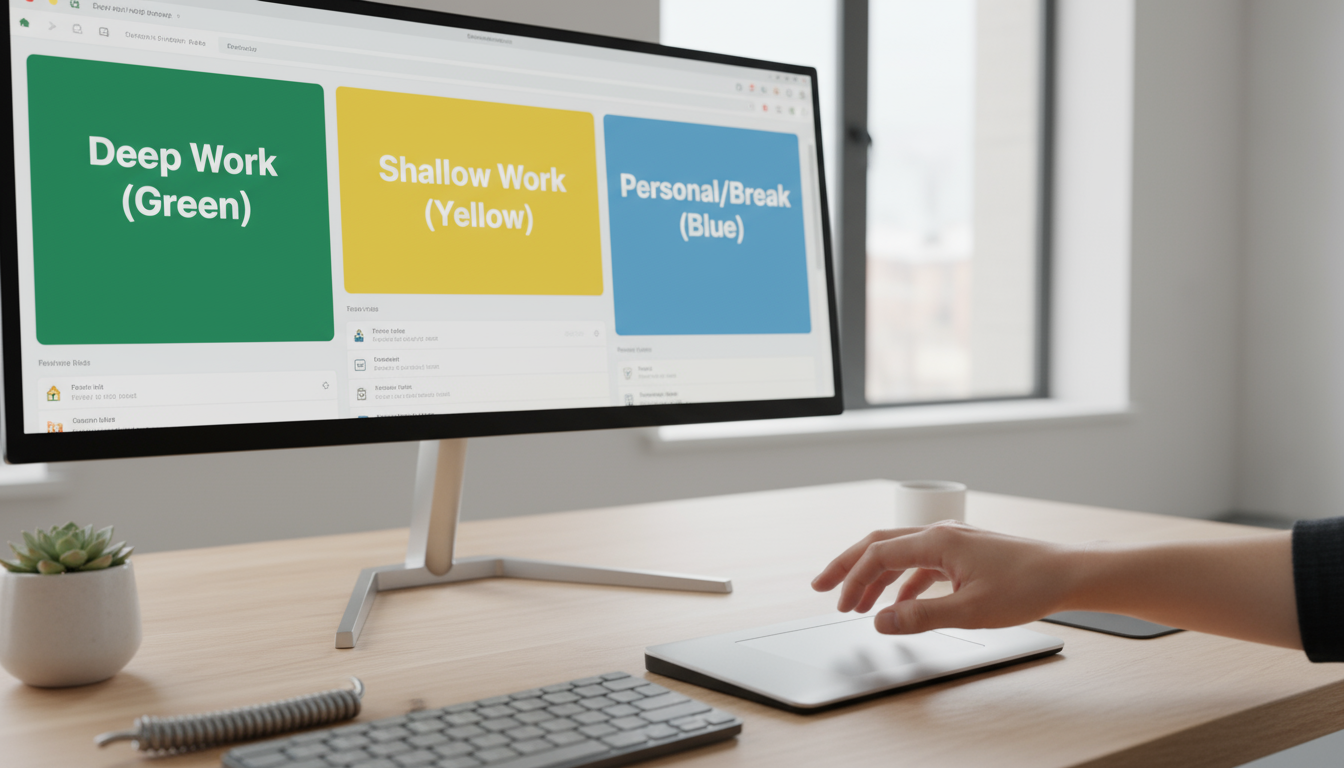
You’re sitting on a crowded train, the city blurring past the window. In one hand, your phone buzzes with new emails. In your ears, a podcast about market trends plays. You’re trying to mentally draft a reply to your boss while simultaneously remembering to pick up groceries on the way home. This is the modern professional’s reality: a constant, frantic juggling act. We call it multitasking, and we wear it like a badge of honor. We believe it’s the only way to keep up with the relentless pace of urban life.
But what if I told you that this badge is a fraud? What if the very strategy you’re using to get ahead is actually holding you back, draining your energy, and producing lower-quality work? The relentless pressure to do more, faster, has sold us a myth. The myth of multitasking.
The truth is, your brain is not designed to do two complex things at once. What you perceive as multitasking is actually rapid-fire task switching, a costly process that fragments your attention and sabotages your best efforts. Here at TheFocusedMethod.com, we coach busy professionals and students just like you to reclaim their focus and achieve more by doing less. This isn’t about rigid, unforgiving schedules. It’s about creating a flexible structure that works with your brain, not against it, especially when navigating the chaos of daily life. Let’s dismantle the multitasking myth and build a better, more effective system together.
📚 Table of Contents
- The Great Deception: Why Multitasking Is Really Context Switching
- Setting Up Your System for Focused Success
- Step 1: Choose Your Core Categories and Colors
- Step 2: Acknowledge Reality with Buffers and Travel Time
- Step 3: Define Your Ideal Week
- Executing the Plan: A Day and Week in the Life of a Single-Tasker
- Guardrails: Handling Interruptions and Overruns Like a Pro
- Optimization: The Weekly Review to Sharpen Your Focus
- Real-World Scenarios: Single Tasking in Action
- Frequently Asked Questions (FAQ)
- What if my entire day is filled with back-to-back meetings?
- How strict should my time blocks be?
- What’s the real difference between time blocking and timeboxing?
- This feels too rigid for a creative person. I need spontaneity!
- What tools do I need for this? Is there a special app?
- Is multitasking ever okay?
- Conclusion: Your First Steps to Reclaiming Your Focus

The Great Deception: Why Multitasking Is Really Context Switching
Let’s get one thing straight: true multitasking is a feat reserved for computers. A human brain trying to write an email while actively participating in a conference call isn’t doing both simultaneously. Instead, it’s performing something called context switching. Imagine your brain has only one spotlight of true focus. When you multitask, you are frantically swinging that spotlight back and forth between tasks. Each time you switch, there’s a cost.
This cost is both time and mental energy. Think about rebooting a computer program. It doesn’t happen instantly. There’s a small lag as it loads the necessary information. Your brain is the same. When you switch from your email to the conference call, your brain has to shut down the “email” context and load the “meeting” context. Then, when you glance back at your email, it has to do it all over again. These micro-seconds of “reloading” add up, leading to significant time loss over a day. Research from organizations like the American Psychological Association (APA) has shown that these mental shifts can cost you up to 40 percent of your productive time.
The drawbacks of multitasking go beyond lost time. It also increases stress. Juggling multiple demands keeps your brain in a state of high alert, increasing cortisol levels and leading to mental fatigue. It also degrades the quality of your work. When your focus is split, you are more prone to making errors, you retain less information, and your creative problem-solving abilities plummet. In the multitasking vs single tasking debate, single tasking wins every time for deep, meaningful work.
The alternative is to embrace single tasking, or monofocus. This means dedicating your full attention to one task for a set period. The tools we use to achieve this are simple but powerful: time blocking, timeboxing, and task batching.

Core Methods for Single Tasking
Time blocking is the practice of scheduling your entire day into specific blocks of time dedicated to particular tasks or activities. Instead of a to-do list, you have a concrete plan on your calendar. You don’t just know what you have to do; you know when and for how long you’ll do it.
Timeboxing is a related concept. With timeboxing, you allocate a fixed, maximum unit of time to an activity. For example, you might give yourself a 25-minute timebox to clear your email inbox. When the timer goes off, you stop, whether you’re finished or not. This helps defeat procrastination and perfectionism, adhering to the principle of Parkinson’s Law: work expands to fill the time available for its completion.
Finally, task batching is the secret weapon for all those small, nagging to-dos. It means grouping similar tasks together and doing them all in one dedicated block. Instead of answering emails as they arrive, you batch them into two 20-minute sessions per day. Instead of making three separate phone calls throughout the day, you do them all back-to-back. This minimizes the cost of context switching and preserves your valuable deep work time.

Setting Up Your System for Focused Success
Transitioning from chaotic multitasking to intentional single tasking requires a plan. Your calendar—whether it’s Google Calendar, Outlook, or a physical planner—is your new command center. The goal is not to fill every second with rigid appointments, but to create a clear, visual guide for your intentions.

Step 1: Choose Your Core Categories and Colors
Start by identifying the main types of activities in your life. A simple color-coding system makes your schedule instantly readable. You don’t need a dozen colors; three to five is plenty. Here’s a pragmatic starting point:
Deep Work (e.g., Green): This is for your most important, cognitively demanding tasks. Writing a report, coding a feature, studying for an exam, or developing a business strategy. These blocks should be sacred and protected from interruption.
Shallow Work / Admin (e.g., Yellow): This is for the necessary but less demanding tasks. Answering emails, filing expense reports, booking appointments, or making phone calls. This is where you’ll use task batching.
Meetings & Communication (e.g., Blue): Any scheduled call, meeting, or collaborative session goes here. This helps you see how much of your day is dedicated to interacting with others.
Personal & Renewal (e.g., Orange): This is non-negotiable. Block time for lunch, breaks, exercise, commuting, and family commitments. If you don’t schedule renewal, your brain will take it anyway—usually in the form of burnout or distraction.

Step 2: Acknowledge Reality with Buffers and Travel Time
One of the biggest mistakes people make is scheduling back-to-back commitments. Life is messy. Meetings run over. A task takes longer than expected. The train is delayed. Build buffers into your schedule. A 15-minute buffer between meetings gives you time to grab water, stretch, and mentally reset before the next context switch. If a task is estimated to take 45 minutes, block a full hour.
If you commute, block that time on your calendar. Don’t treat it as “free time” to cram in more work. Use it intentionally. It could be a time for decompressing with music, learning with a podcast, or simply observing the world around you. By scheduling it, you acknowledge it’s a part of your day and prevent other tasks from bleeding into it.

Step 3: Define Your Ideal Week
Look at your week from a bird’s-eye view. Are there certain days better suited for certain types of work? Maybe Monday is your heavy meeting day, so you schedule your shallow work around those calls. Perhaps you work from home on Wednesdays and Fridays, making those ideal for long, uninterrupted deep work blocks. Your schedule should reflect your energy levels and environment. Don’t fight your reality; design around it. Remember the 80/20 Rule, also known as the Pareto Principle: roughly 80% of results come from 20% of the effort. Identify your high-impact “20%” tasks and give them the best, most protected time slots in your week.

Executing the Plan: A Day and Week in the Life of a Single-Tasker
Theory is one thing; practice is another. Let’s walk through what this system looks like on a typical Tuesday for a busy professional.

A Day in Focus
7:00 AM – 8:00 AM (Orange Block): Morning Routine. Wake up, hydrate, maybe do some light stretching or meditation. The key is to avoid checking your phone first thing. This hour is about setting a calm, intentional tone for the day, not reacting to the world’s demands.
8:00 AM – 8:45 AM (Orange Block): Commute. Instead of frantically answering emails on a crowded bus, you listen to an audiobook. You arrive at the office feeling centered, not frazzled.
8:45 AM – 9:00 AM (Yellow Block): Triage. You spend a 15-minute timebox scanning your inbox. You’re not replying to everything. You’re identifying anything truly urgent and getting a lay of the land for the day. You’re in control.
9:00 AM – 10:30 AM (Green Block): Deep Work Session 1. This is a 90-minute, uninterrupted block dedicated to your most important task of the day. Notifications are off. Your door is closed or you have headphones on. You are fully immersed in a state of focus.
10:30 AM – 10:45 AM (Orange Block): Buffer & Break. You get up, stretch, walk to the kitchen for coffee. You do not check your email. This break allows your brain to consolidate information and recharge.
10:45 AM – 12:00 PM (Blue Block): Team Strategy Meeting. Because you aren’t trying to multitask, you are fully present. You contribute meaningfully, take clear notes, and understand the action items. You are an active participant, not a passive observer.
12:00 PM – 1:00 PM (Orange Block): Lunch. You step away from your desk. You eat mindfully. You might take a short walk outside. This is a critical energy renewal period.
1:00 PM – 2:30 PM (Green Block): Deep Work Session 2. Another focused sprint on a high-priority project. You build on the momentum from the morning.
2:30 PM – 3:15 PM (Yellow Block): Admin & Email Batch. Now is the time to respond to the non-urgent emails from the morning, make a few quick calls, and handle administrative tasks. You clear the decks efficiently because you’re doing similar tasks together.
3:15 PM – 3:30 PM (Orange Block): Buffer & Break. A quick mental reset.
3:30 PM – 4:30 PM (Blue Block): Client Call. You are prepared and engaged.
4:30 PM – 5:00 PM (Yellow Block): Daily Shutdown. You review what you accomplished, clarify your plan for tomorrow, and do a final 15-minute email check. You close your laptop feeling a sense of completion, not open-ended anxiety.

A Week in Focus
Zooming out, the week has a rhythm. Monday might be for planning and team alignment meetings. Tuesday and Thursday could be your prime deep work days, with minimal meetings. Wednesday might be for external calls and collaborations. Friday afternoon is reserved for a weekly review and planning for the week ahead, ensuring you start the next Monday with clarity and purpose.

Guardrails: Handling Interruptions and Overruns Like a Pro
No plan survives contact with reality. Your perfectly crafted schedule will inevitably be challenged by an urgent request from your boss, a meeting that runs 30 minutes over, or a task that proves far more complex than you anticipated. A pragmatic system doesn’t break under pressure; it flexes.

Handling Unexpected Interruptions
When a colleague stops by your desk or an “urgent” email lands in your inbox during a deep work block, you have a choice. Your first instinct might be to drop everything—a classic multitasking trap. Instead, pause and assess. Is it truly urgent (the building is on fire) or is it just someone else’s priority? Most of the time, it’s the latter.
Politely protect your block. You can say, “I’m in the middle of something focused right now. Can I get back to you at 11:30?” or “I’ve seen your email. I have a block scheduled for that project this afternoon and will address it then.” You are not saying no; you are saying when. This simple act of renegotiating the timeline keeps you in control of your schedule and respectfully manages others’ expectations.

Managing Overruns
What happens when your 90-minute block for “Drafting the Q3 Report” isn’t enough? First, don’t panic. This is valuable data. It tells you that you may need to estimate more generously for this type of task in the future. Second, you have options. You can either use a pre-scheduled “flex block” later in the day to continue the work, or you can make a conscious decision to trade time from another, less critical block. For example, maybe you shorten your afternoon admin batch by 30 minutes to finish the report.
The key is to make a conscious choice. Don’t let the overrun derail your entire day. Adjust the plan deliberately. Your calendar is a living document, a map for your day. Sometimes you need to take a detour, and that’s okay as long as you’re the one holding the map.

When Meetings Take Over
Some days are just a wall of meetings. On these days, your goal shifts. You can’t schedule long deep work blocks, so you focus on maximizing the effectiveness of the meetings and the small gaps between them. Be fully present in each meeting. When you have a 15-minute gap, use it for a hyper-focused task batch—answer three critical emails, make one phone call. This prevents the small tasks from piling up and overwhelming you later. Protect your pre- and post-meeting time fiercely to prepare and debrief, ensuring the communication time is as productive as possible.

Optimization: The Weekly Review to Sharpen Your Focus
A time management system is not a “set it and forget it” tool. It’s an iterative process of planning, executing, and refining. The most critical component of this feedback loop is the weekly review. This is your 30-minute meeting with yourself, typically held on a Friday afternoon, to assess what worked, what didn’t, and how you can improve for the week ahead.

The Three-Question Review
Keep your review simple and actionable. Pour a cup of coffee and ask yourself three questions while looking back at your calendar for the past week:
1. What went well? Did you successfully protect your deep work blocks? Did task batching save you time? Did you end most days feeling accomplished instead of exhausted? Acknowledge your wins. This builds momentum and reinforces good habits.
2. What were the challenges? Where did the plan fall apart? Did a specific project consistently take longer than planned? Were you constantly interrupted on a particular day? Be honest and curious, not judgmental. This isn’t about failure; it’s about gathering data.
3. What will I adjust for next week? Based on your answers, what’s one small change you can make? If you underestimated task times, you might add a 25% buffer to your estimates next week. If Wednesdays were chaotic, maybe you proactively block off a “no meetings” morning. These small, incremental adjustments are what transform the system from a rigid template into a personalized productivity engine.

Metrics to Watch
As you get more advanced, you can track a few simple metrics to gauge your progress. You don’t need complex spreadsheets. Just a quick mental or written note will do.
Energy Levels: On a scale of 1-5, how was your energy at the end of each day? If you’re consistently ending at a 1 or 2, your schedule might be too packed or lacking sufficient renewal time.
Deep Work Count: How many deep work blocks did you successfully complete versus how many you scheduled? This shows how well you’re protecting your most valuable time.
Rollover Rate: How many tasks scheduled for one day had to be pushed to the next? A high rollover rate suggests your daily plans are too ambitious, and you need to schedule fewer tasks or be more realistic with time estimates. The goal is not zero rollover, but a manageable, low-stress amount.
By regularly checking in with your system and your own experience, you ensure that your approach to time management evolves with your role, your priorities, and your life. It is the opposite of the mindless, reactive state that multitasking fosters.

Real-World Scenarios: Single Tasking in Action
Let’s see how this method applies to two common, challenging scenarios: a hybrid worker juggling home and office life, and a student with a complex academic schedule.

Scenario 1: Sarah, the Hybrid Worker
Sarah works for a tech company, spending Tuesdays and Thursdays in the city office and the rest of the week at home. Her biggest challenge is the context switch between a collaborative office environment and a quiet home office.
Her Strategy: Sarah designs her weeks thematically. Tuesdays and Thursdays are “collaboration days.” She stacks her in-person meetings, team brainstorming sessions, and one-on-ones on these days. Her calendar is dominated by blue (Meetings) and yellow (Shallow Work) blocks. She blocks her commute time (orange) and uses it to listen to industry podcasts to gear up for the day. She accepts that deep work will be minimal on these days and focuses on being present and connected with her team.
Mondays, Wednesdays, and Fridays are her “focus days.” Her calendar is primarily green (Deep Work). She schedules 2-3 long, protected blocks for strategic planning and coding. She batches all her household chores, like laundry and meal prep, into a single block on Monday morning to get them out of the way. By aligning the type of work with her environment, she minimizes the friction of multitasking between her professional and domestic roles and makes significant progress on her core projects.

Scenario 2: Leo, the University Student
Leo is a biology major with a heavy course load, lab sections, a part-time job, and group projects. His schedule is dictated by fixed class times, and he feels like he’s always “on,” constantly switching between subjects and responsibilities.
His Strategy: Leo uses time blocking to create structure within his fragmented schedule. He treats his classes and labs as non-negotiable blue blocks. Then, he looks at the gaps. Instead of vaguely thinking “I should study,” he creates specific green blocks like “BIO 201: Review Lecture Notes” or “CHEM LAB: Write Pre-Lab Report.” This specificity overcomes procrastination.
He uses timeboxing extensively. He gives himself a 45-minute timebox to work on a problem set. When the time is up, he takes a 15-minute break, a technique he learned that’s similar to the Pomodoro method. The small gaps between classes—20 or 30 minutes—are perfect for task batching (yellow blocks). He uses this time to reply to all his group project emails or to review flashcards. He also schedules personal time (orange blocks) for the gym and social activities, preventing burnout. For Leo, the battle of multitasking vs single tasking is won by transforming chaotic, open-ended “study time” into a series of clear, focused, and achievable sprints.

Frequently Asked Questions (FAQ)
What if my entire day is filled with back-to-back meetings?
This is a common reality for managers and executives. On these days, shift your definition of success. The goal isn’t deep work; it’s high-quality interaction. The best application of single tasking here is to be fully present in each meeting. Don’t check email or work on other things. Give the person and topic your full attention. Use the 5-10 minute gaps between calls to stand, stretch, and reset, not to start a new task. Protect the 30 minutes at the start and end of your day for planning and wrap-up. This ensures you enter and exit the meeting marathon with clarity and control.
How strict should my time blocks be?
Think of your calendar as a map, not a cage. The plan is a guide for your intentions, not a rigid set of rules. If you get into a state of flow on a project, it’s okay to “borrow” time from the next block, as long as it’s a conscious decision. The purpose of the blocks is to fight against distraction and provide a default path for your attention. If you consistently find yourself ignoring your blocks, it’s a sign that your plan might be unrealistic, and it’s time to adjust during your weekly review.
What’s the real difference between time blocking and timeboxing?
They are closely related but serve slightly different purposes. Time blocking is about assigning a task to a specific time slot on your calendar (e.g., “9-11 AM: Work on Project X”). The focus is on ensuring the important work has a dedicated home. Timeboxing is about assigning a maximum amount of time to a task (e.g., “I will spend no more than 25 minutes on email”). The focus is on limiting perfectionism and controlling the time spent on a task, regardless of when it happens. You can use them together: “I have a time block from 9-10 AM, and within it, I will use two 25-minute timeboxes to work on my presentation.”
This feels too rigid for a creative person. I need spontaneity!
This is a common concern, but structure actually enables creativity. When you don’t have a plan, your brain spends its energy deciding what to do next, which is draining. By blocking out the mandatory tasks, you free up mental bandwidth. More importantly, you can—and should—schedule spontaneity! Block out a “Flex Time” or “Exploration” period in your week. This is a dedicated time for whatever feels right: reading an interesting article, brainstorming new ideas, or going for a walk. By scheduling freedom, you ensure it actually happens.
What tools do I need for this? Is there a special app?
The best tool is the one you will use consistently. You don’t need a fancy or expensive app. Google Calendar, Microsoft Outlook, a simple paper planner, or even a notebook can work perfectly. The power is in the method, not the medium. Start with whatever calendar you already use. The goal is to reduce friction, not add another complex tool to your life.
Is multitasking ever okay?
Yes, for low-stakes, habitual tasks. You can absolutely listen to a podcast while washing the dishes or fold laundry while talking on the phone with a friend. These pairings work because at least one of the tasks is largely automatic and requires very little cognitive load. The danger of multitasking arises when you try to pair two or more tasks that both require significant attention and focus, like writing and attending a meeting.

Conclusion: Your First Steps to Reclaiming Your Focus
The promise of doing everything at once is a siren song that leads to burnout, stress, and mediocre results. The multitasking myth has convinced us that being busy is the same as being productive. It’s not. True productivity, the kind that leads to meaningful accomplishments and a sense of calm control, comes from intentional, focused effort. It comes from embracing single tasking.
By defining your work, structuring your time with intention, and building a flexible system that can handle the unpredictability of life, you trade frantic reactivity for focused proactivity. You stop being a victim of your schedule and become its architect. The health of your mind and the quality of your work depend on this shift. For more insights on building sustainable productivity habits, you can explore resources from health leaders like the National Institutes of Health (NIH) and the Sleep Foundation, which emphasize the deep connection between rest, focus, and overall well-being.
Feeling overwhelmed? Don’t try to change everything at once. Start small. Here are three concrete actions you can take this week to begin your journey away from multitasking:
1. Schedule One Deep Work Block: Look at your calendar for tomorrow and find one 60-90 minute window. Block it off for your single most important task. When the time comes, turn off all notifications, close unnecessary tabs, and give it your full attention.
2. Batch Your Emails: Instead of checking email constantly, schedule two or three specific 20-minute blocks to process your inbox. Outside of those times, keep your email client closed. Notice how much more focused you are on your primary tasks.
3. Practice a Mindful Transition: Between your next two meetings or tasks, don’t immediately jump to the next thing. Take three minutes. Stand up, stretch, take a few deep breaths, and drink a glass of water. Consciously close the mental file on the last task before opening the next one.
These small steps are the beginning of a profound shift. They are the foundation of working with your brain’s natural ability to focus, leading to better work, less stress, and more time for what truly matters.
Disclaimer: The information provided in this article is for informational purposes only and does not constitute medical, legal, or professional advice. Please consult with a qualified professional for advice tailored to your specific situation.






